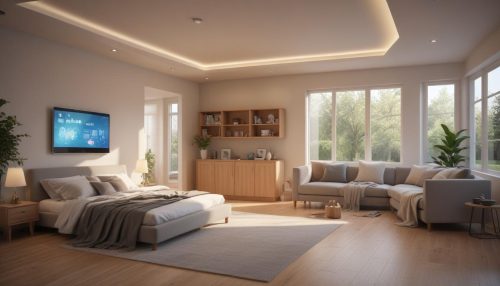Smart Home Upgrades You’ll Want to Explore
Olivia Morgan August 23, 2025
Curious about which smart home upgrades truly enhance daily living and energy savings? This detailed guide explores practical home automation ideas, the benefits of smart thermostats, energy-efficient lighting, and how connected devices can boost security and comfort in any home environment.
Understanding the Impact of Smart Home Upgrades
Smart home technology is more than a trend—it’s changing the way people interact with their living spaces. Homeowners are increasingly drawn to connected devices, which offer seamless control over lighting, security, heating, and appliances. By adopting smart home upgrades, individuals can monitor energy usage, automate routines, and even enjoy peace of mind while away from home. With the growing ecosystem of home automation products, entry points for every budget and need have emerged, making it easier to get started or expand incrementally.
One of the key advantages of smart home upgrades is increased energy efficiency. Devices such as smart thermostats learn usage patterns and adjust heating and cooling settings automatically for optimal comfort and savings. Energy-efficient lighting systems allow remote scheduling and dimming, contributing to lower utility bills. These innovations aren’t just about convenience; they also have a measurable impact on sustainability efforts, reducing a home’s overall carbon footprint.
Another important benefit is improved security. Homeowners can receive instant alerts if sensors detect unusual activity or if smart locks are accessed. Security cameras and video doorbells offer high-definition live feeds, helping households monitor visitors, deliveries, or unexpected events in real time. These features make smart home upgrades a valuable choice for individuals interested in both convenience and safety, integrating seamlessly with mobile devices for easy monitoring from anywhere.
Smart Thermostats: Comfort and Cost Savings
Smart thermostats have revolutionized climate control in modern homes. By using motion sensors and occupancy schedules, these devices adapt heating and cooling cycles to actual needs. Over time, this learning process leads to more personalized comfort as well as significant energy savings. Many models offer remote control via smartphone apps, allowing individuals to make adjustments on the fly—whether on the couch or hundreds of miles away.
The financial benefits of installing a smart thermostat can be impressive. According to the U.S. Department of Energy, adjusting thermostats by 7-10 degrees for eight hours a day can save up to 10% per year on heating and cooling costs (https://www.energy.gov/energysaver/thermostats). Smart thermostats automate these savings by maintaining comfort when occupants are present and reducing energy use when the home is empty. Over time, these savings accumulate, helping offset the device’s initial investment.
Compatibility and installation are important factors to consider. Most smart thermostats connect to standard HVAC systems, but integration with other smart home devices can further enhance their effectiveness. For example, pairing with window sensors can ensure energy isn’t wasted if a window is left open. These upgrades are often user-friendly, making professional installation optional for many homeowners.
Energy-Efficient Lighting: More Than Just LEDs
Lighting plays an essential role in smart home design, extending beyond simple on-off schedules. LED bulbs are now the baseline for efficiency, but smart lighting systems bring new levels of flexibility and savings. With app-based controls or voice commands, lights can be adjusted throughout the day for specific tasks or moods—improving comfort while minimizing wasted energy.
Features such as occupancy sensors and adaptive dimming help keep lighting in tune with household activity patterns. In practice, lights turn off automatically in unoccupied rooms and adjust brightness according to natural daylight, further reducing electricity consumption. These small improvements add up and can be especially impactful in larger homes or spaces where lights are often left on by accident.
Smart lighting systems are also accessible to renters and those not seeking major electrical work. Plug-in smart switches and adapters make it easy to upgrade lamps and fixtures without rewiring. For those looking to start small, even a few connected bulbs installed in high-use areas provide an immediate sense of convenience and control, showing the scalability of these home upgrades.
Boosting Home Security with Connected Devices
Security remains a top priority for many households. With smart security cameras and video doorbells, monitoring entrances and outdoor spaces has become both simple and robust. These devices provide clear video feeds, two-way audio, and cloud-based storage options, helping to deter unwanted activity and provide documentation if needed.
Integration with smartphone apps allows for real-time notifications. Whether it’s a visitor ringing the doorbell or movement detected at night, alerts arrive immediately. Many newer systems include artificial intelligence for distinguishing between people, animals, and vehicles, reducing false positives and ensuring peace of mind without unnecessary interruptions.
For additional security, smart locks and window sensors can automate access while allowing for temporary digital keys to be issued to guests or service providers. This enhances flexibility—gone are the days of hiding spare keys under doormats. Connected alarm systems round out protection, offering a layered and customizable approach that many find reassuring in today’s unpredictable world.
Voice Assistants and Seamless Home Integration
Voice assistants serve as the nerve center for many smart home systems. Devices from major brands integrate with hundreds of products, enabling hands-free operation of thermostats, lighting, security, and even appliances. Simply speaking a command can set the mood for an evening or initiate a morning routine. This convenience is especially helpful for busy households or individuals with mobility needs.
Beyond simple commands, routines and automations let homeowners program complex tasks. For instance, a “goodnight” command might lock all doors, adjust the thermostat, turn off lights, and arm the security system. This level of integration isn’t just futuristic—it’s practical, streamlining daily life and potentially increasing safety and comfort for all members of a household.
Privacy is a common concern with voice-enabled devices. Major providers have implemented robust encryption and user controls, though it’s wise to review privacy policies and adjust device settings as desired. With proper management, the benefits of seamless integration far outweigh the potential risks for most users.
Smart Appliances That Improve Everyday Living
Appliances now offer connectivity and smart features that make chores easier and more efficient. Washing machines, refrigerators, ovens, and even vacuum cleaners can connect to Wi-Fi for remote monitoring and control. These features often include energy tracking, maintenance alerts, and customization of cycles based on daily routines or changing needs.
A smart refrigerator, for example, can notify its owner when the door is left open or when it’s time to replace a filter. Some models can even help track grocery inventory or suggest recipes based on available ingredients. By easing household management, these appliances free up time for other priorities.
In addition to convenience, many smart appliances deliver efficiency gains. Dishwashers and laundry machines can run during off-peak energy hours to minimize electricity costs. Remote troubleshooting and software updates can extend product lifespan, emphasizing both environmental responsibility and long-term savings for modern households.
References
1. U.S. Department of Energy. (2023). Thermostats. Retrieved from https://www.energy.gov/energysaver/thermostats
2. ENERGY STAR. (2023). LED Light Bulbs. Retrieved from https://www.energystar.gov/products/light_bulbs
3. National Institute of Standards and Technology. (2022). Smart Home Security. Retrieved from https://www.nist.gov/programs-projects/smart-home-security
4. Federal Trade Commission. (2022). Understanding Smart Home Privacy. Retrieved from https://consumer.ftc.gov/articles/connected-homes-privacy-security
5. Consumer Reports. (2023). Smart Thermostat Buying Guide. Retrieved from https://www.consumerreports.org/home-garden/thermostats/buying-guide
6. U.S. Environmental Protection Agency. (2023). Saving Energy at Home. Retrieved from https://www.epa.gov/energy/saving-energy-home





